PC version update: The vast, beautiful, desolate world of Death Stranding lives on PC in top-notch form. After about 15 hours with the game, I'm drawn back into its melodramatic story and unique gameplay loop of cargo delivery simulation and harrowing stealth-action. To reconnect the country in Death Stranding is to also connect with the many players who are doing the same, and through asynchronous multiplayer design, you both engage in rebuilding the world together while helping one another do your in-game jobs.
Given the right specs, the PC version of Death Stranding can look and run much better than it did on the PS4 Pro (I played using a Core i7-7700K CPU and RTX 2080 video card). I ran 2560x1080 resolution, as the game supports native 21:9 ultrawide aspect ratio, and every setting maxed out while using Nvidia's DLSS antialiasing option. And through action sequences and heavy weather hikes, the frame rate is consistently in the high 90 FPS to 110 FPS. This is a proper PC port that looks stunning and runs smooth.
If you're in the mood for a different style of gaming experience, one that's often relaxing and sometimes incredibly tense, Death Stranding is worth playing. -- Michael Higham, July 13, 2020
You can read our original review for the PS4 version, first published November 1, 2019, below.
America is broken, and it's up to you to put it back together again. It's a tall order. A lot of people believe in it, but you're not sure you do. It'll take a lot of lonely, dangerous walks and exceptionally heavy lifting, and it's not really clear what America means in the first place. For some reason, you set out anyway, trudging through wetlands and rocky hills on foot, not fully knowing or understanding where you're going. Other than the monsters you can't quite see, there's not really anyone else around most of the time--just you and your thoughts, one foot in front of the other.
On one level, Death Stranding is about America. But your actual goal in setting out across the country is to help people, bring them together, and forge connections, not for the vague concept of America but for the sake of helping the people within it. Death Stranding is unrelenting in its earnestness and optimism--certainly not without its critiques of America, nor without its challenges and setbacks, but inherently hopeful nonetheless. It is a dense, complex, slow game with a plot that really goes places, but at its core, it never stops being about the sheer power and purpose we can find in human connection, and that is its most remarkable achievement.
Hands Across America
Rebuilding the country is as simple as getting every far-flung city, outpost, and individual onto one network, the bones of which were laid down by a pseudo-government organization called Bridges. As Sam Porter Bridges (played by Norman Reedus), all you have to do to win people over is bring them packages; most people never go outside due to mysterious monsters called BTs, but unlike most people, Sam can sense them enough to sneak past them and get important cargo to its destination.
Deliveries can be arduous. You're evaluated on your deliveries across a few categories, but the condition of the cargo can make or break a run, and there are a lot of factors working against you. The landscape can be extremely punishing, from expanses of exhaustingly rocky hills to rivers that are too deep and wide to cross unaided. On top of BTs, you also have to contend with Timefall, a kind of rain that rapidly accelerates aging and deterioration for most of the things it touches. Extended exposure to Timefall can damage or completely ruin your cargo, as can slipping and falling, getting hit by an enemy, or, in some cases, just being a little too rough with it. Even the smallest rocks can trip you up, too. In order to keep your footing, you need to pay close attention to where you're stepping, keeping your balance with the triggers while on rough terrain or when carrying a lot of stuff.
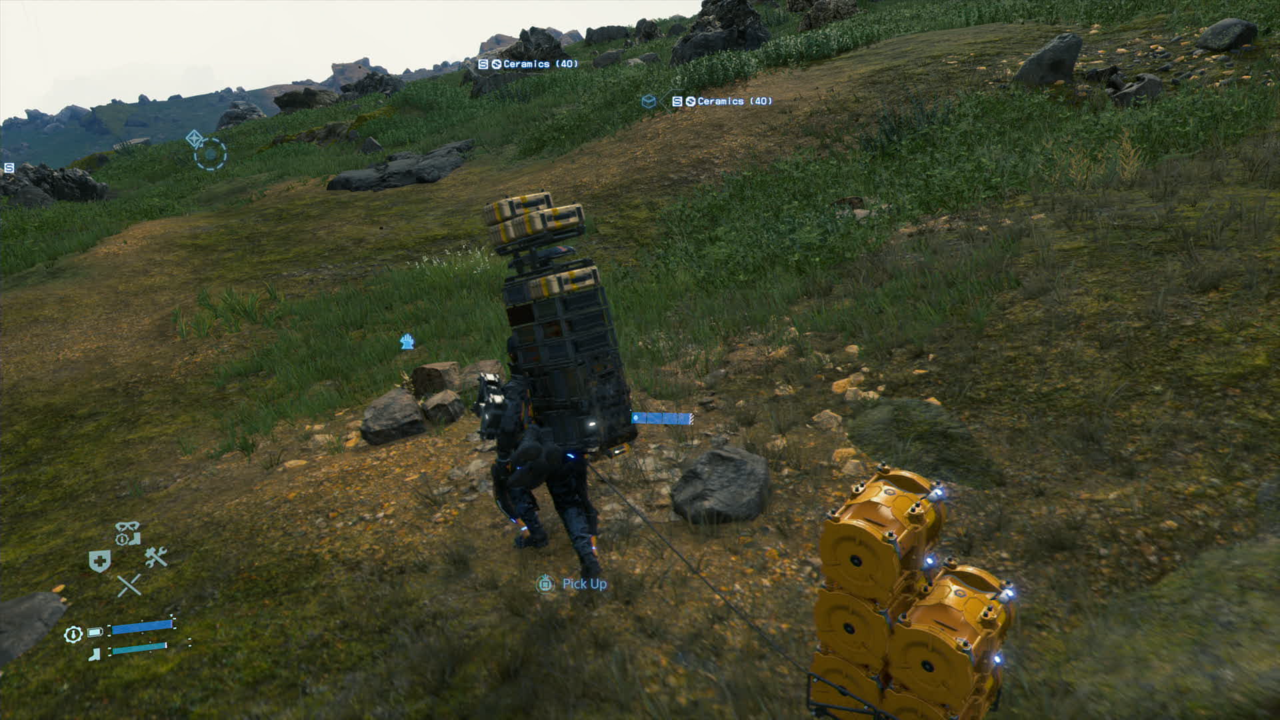
Once you reach your destination, though, you're showered with praise. The recipient will likely thank you to your face (albeit as a hologram), and then they'll give you a series of social media-style likes. You're inundated with a multi-page results screen itemizing all the likes you received for the delivery and in which categories, plus an overall rating for the delivery itself, no matter how small--it's positive reinforcement turned up to 11. These likes then funnel into each of the delivery categories like experience points, and as you level up, you can carry more weight or better maintain your balance, among other benefits. Deliveries also feed into a connection rating with each city, outpost, or person, and as that increases, you acquire better gear and sometimes gifts to reward your efforts further.
In short, you give a lot and get a lot in return. There is a relatively small number of mandatory deliveries to advance the story, but there's a seemingly unlimited number of optional deliveries, and I often found myself picking up orders destined for any place that was on my way. It's a cycle that's easy to get swept up in; no matter how difficult a delivery or how far the distance, you will at least be met with gratitude, likely feel fulfilled from having completed a tough delivery, and often given a tool to make future deliveries a bit easier. Most importantly, though, increasing your bonds with people is how you get them on the network, and the network is what elevates this core loop beyond the simple satisfaction of completing tasks and getting rewards.
The chiral network is a kind of souped-up internet that allows you to 3D print objects, which is incredibly useful and a strong incentive in itself. When at a terminal connected to the chiral network, you can print ladders and ropes for traversal, new boots as yours wear out, repair spray for damaged containers, and basically anything else you need to safely deliver cargo so long as you have a blueprint for it. You can also print a portable printer that builds structures for you out in open areas covered by the network--things like bridges, watchtowers, and generators, the latter of which are critical as you start to use battery-powered exoskeletons and vehicles.
The chiral network also grants you access to the online component of the game, which is absolutely essential. You never see other players in the flesh, but their impact is all around you; once an area is on the network, you can see structures and objects left behind by other players in the course of their own journeys, plus helpful signs they've put down just for those who come after them. You can pick up someone else's lost cargo and deliver it for them, too, knowing that someone else may find yours at some point and do you the same kindness.
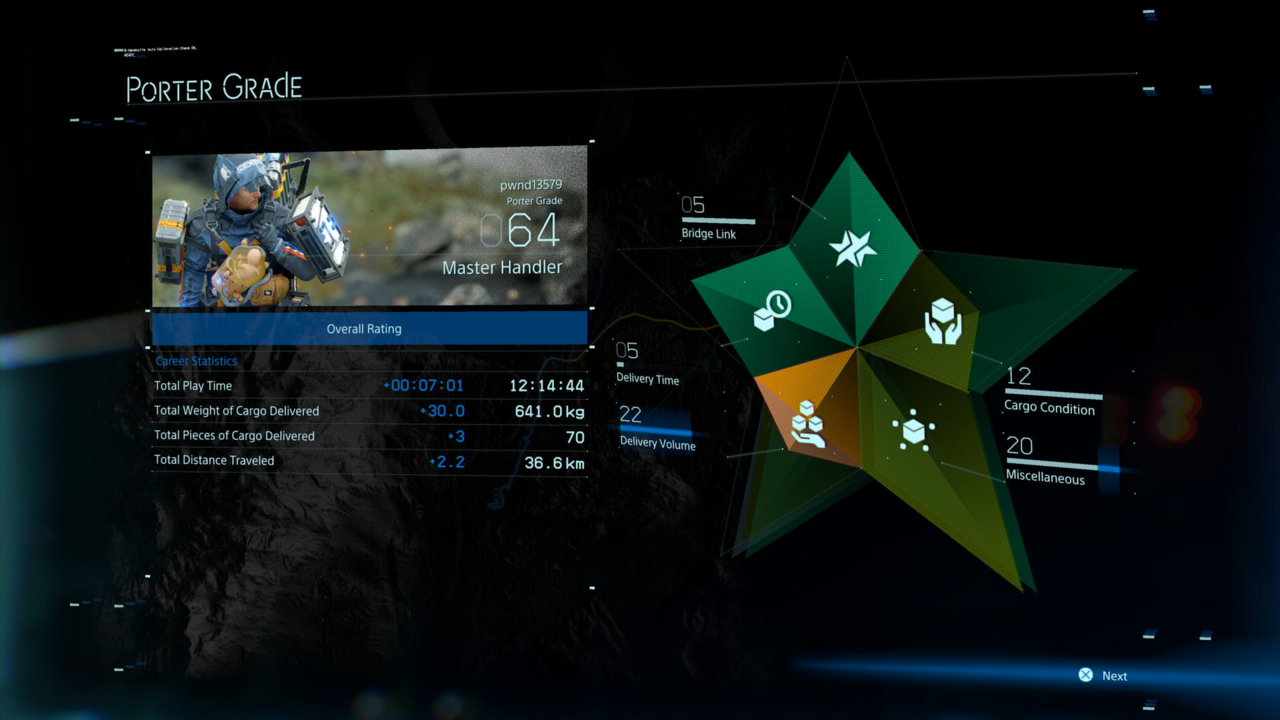
In Death Stranding's best moments, the relief and gratitude you can feel toward someone you don't even know is an unrivaled multiplayer experience. At one point in my playthrough, I was being chased by MULEs, human enemies who love to steal cargo. I was on a bike, tasked with a time-sensitive delivery, almost out of battery and totally unequipped to deal with external threats. In my panic, I drove my bike into a ravine. As I slowly made my way up and out of it, I watched as my bike's battery dipped into the red, and I dreaded getting stuck with all my cargo and no vehicle, still quite a ways away from my destination. I rounded a corner and found myself in the charging area of a generator placed by another player, as if they'd known I'd need it in that exact spot at that exact moment. They probably just put it there because they needed a quick charge, but to me, it was a lifeline.
You can give and receive likes for these player-to-player structures, and just like with standard deliveries, it's a strong incentive to do something helpful for someone else. In the earlier sections of the game, I was using other people's structures far more than I was leaving behind help for others. But I wanted to pay it forward and know that my help was appreciated, so I started going out of my way to build structures I myself didn't really need; the map shows the online structures in your instance, making it easier to spot areas you could fill in for others. At first, the likes system seems like a pretty obvious commentary on social media and our dependence on external validation. But it's not so much a critique as it is a positive spin on a very human need for acceptance, and the system does a remarkable job of urging you to do your best for those around you, NPCs and real people alike. Feeling truly appreciated can be a rare occurrence in life, and it's powerful in its simplicity here.
The Super BB Method
The first few hours of the game are the slowest, and a large part of that is because you don't have access to the online component right away. It's an incredibly lonely stretch of time during which you mostly just walk; the work you do early on is especially laborious in the absence of advanced gear, and it serves to give you an appreciation for other players and better gear as you move forward.
Even as the gameplay opens up, you continue to get a lot of story exposition with almost no explanation. It can all seem kind of goofy at first, and you can get lost in the metaphors; every city you need to add to the chiral network has "knot" in its name, for example, and they are all referred to as "knots" on a strand that connects the country. There's bizarre and unwarranted product placement in the form of Monster Energy drinks and the show Ride with Norman Reedus. Guillermo del Toro's likeness is used for a kind of dorky character called Deadman, and there's a woman named Fragile in a game about delivering packages.
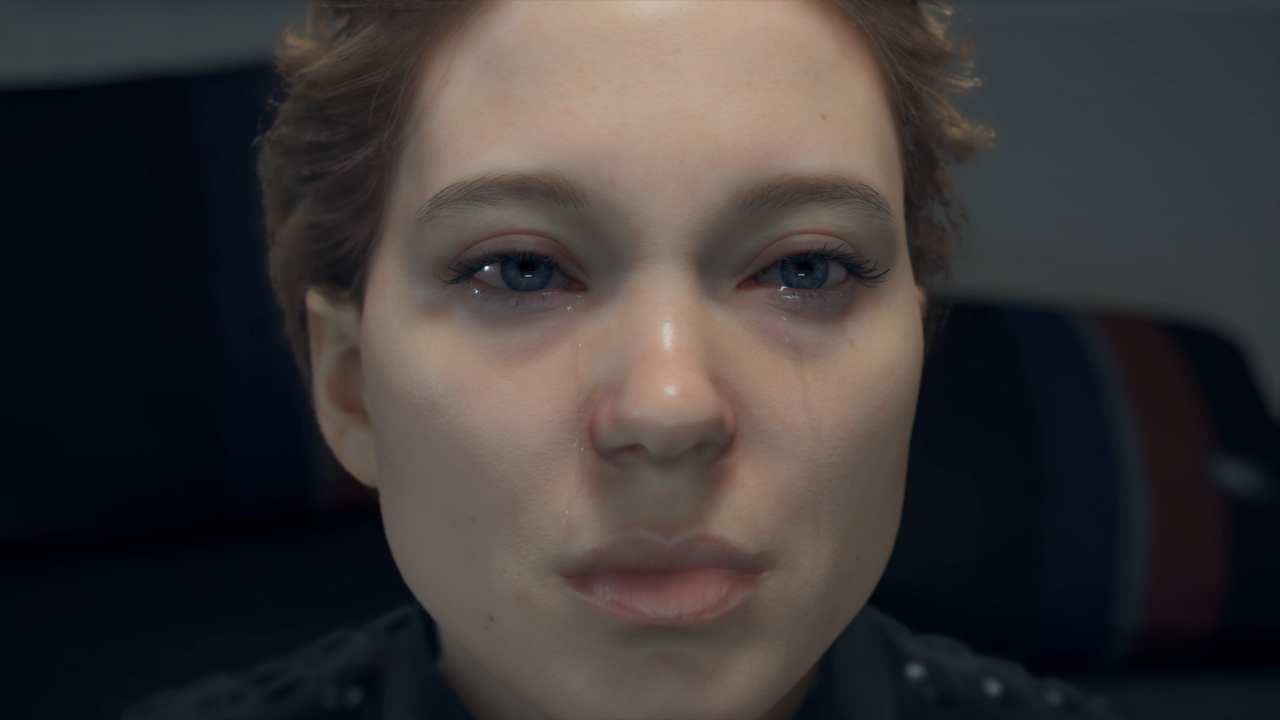
But the story really does go deeper than that. In keeping with the theme of human connection, each of the core characters you meet and work with has their own story to tell. They all have a unique perspective on death that lends them an equally unique perspective on life, and unravelling their characters, down to the true origins of their often literal names, contributes to the overall tapestry of Death Stranding's take on the human experience. As they open up to Sam, Sam opens up to them in turn, developing into a distinct character in his own right out of the reserved, emotionless man he appears to be at the start. I grew to love Sam, Fragile, and Heartman especially, and even the characters I didn't like as much add to the game's overall message about hope and love in the face of adversity.
By far my favorite character--and the most important one--is BB. BBs are infants in pods that can detect the presence of BTs, and they're issued to porters like Sam to help them navigate dangerous territory. You're told to treat BBs like equipment, not real babies, but it's impossible to think of your BB that way. It's full of personality, giggling when happy and crying when stressed out; it even gives you likes from time to time. There aren't many children left in Death Stranding's isolated, fearful world, but BB is your reminder that the future is counting on you, regardless of how you feel about America itself. The love that grows between Sam and BB is nothing short of heartwarming.
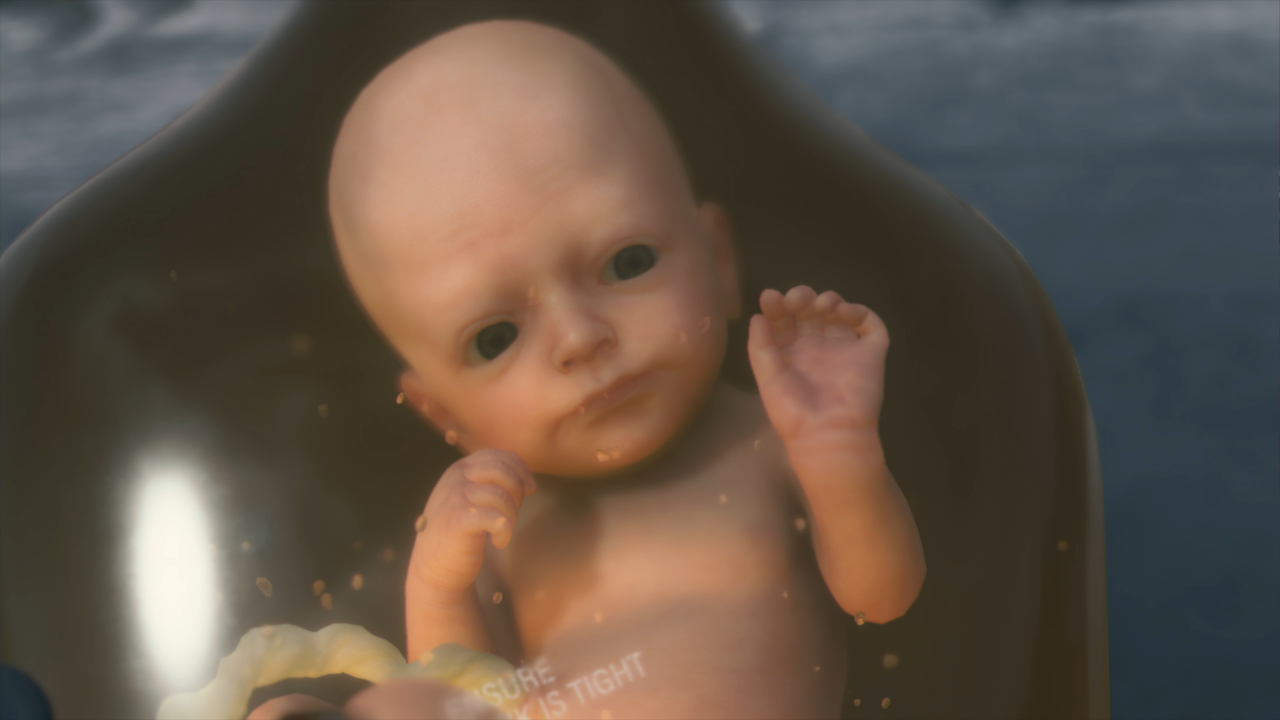
Connecting with this story, just as with connecting with NPCs and other players, can take work. It's not a story that immediately clicks on a surface level, and the dramatic mystery and off-the-wall science don't make too much sense at first blush. But it's an emotional story first and foremost, and making sense of things--while entirely possible, particularly if you read the letters and interviews that detail small bits of lore as you go--is not as important as reflecting on how it makes you feel.
You have plenty of opportunities to do that, too. In the quiet moments of travel, usually as you near your destination, music might start to play. The soundtrack, which is largely composed of one band--Low Roar--is phenomenal, the kind of contemplative folk-ish music that suits a trip alone through a meadow or down a mountain. Because the act of walking is so involved, it's not a time to detach completely and zone out; it's a time to feel your feelings or at least consider what's next in your travels.
Fight, But Not To The Death
You can just as soon be ripped out of that headspace, though, by a shift to the haunting music that signals BT territory. The otherworldly growls of BTs as they close in on you can be terrifying, and early on, your best bet is to freeze in your tracks and hold your breath for as long as you can so you can quietly sneak by them. But there are times when you have to fight a BT in its true form, and for that, you have specialized weapons to take them down. These BTs aren't the ethereal humanoid shapes that float above the ground but huge eldritch horrors that screech under clouds of blood. The combat is mechanically simple--you mostly have to move around a bit and hit them before they hit you--but the sequences are visually and aurally arresting.
You don't get a gun that works on live enemies until 25 or so hours in, but even then, it's non-lethal. You are actively guided away from killing in Death Stranding, because when people die, their bodies basically go nuclear and level cities, leaving nothing but craters and BTs in their wake. On top of that, the main human enemies are MULEs, former porters just like Sam that have been corrupted by an automated world--they've essentially become addicted to snatching cargo in their desperation to have a job and a purpose as more and more people become replaced by machines. They're not evil, and killing them seems like, well, overkill; it's easy enough to knock them out with the nonlethal methods you continue to unlock as the game progresses. I didn't kill a single one in my playthrough, though punching them is satisfying.
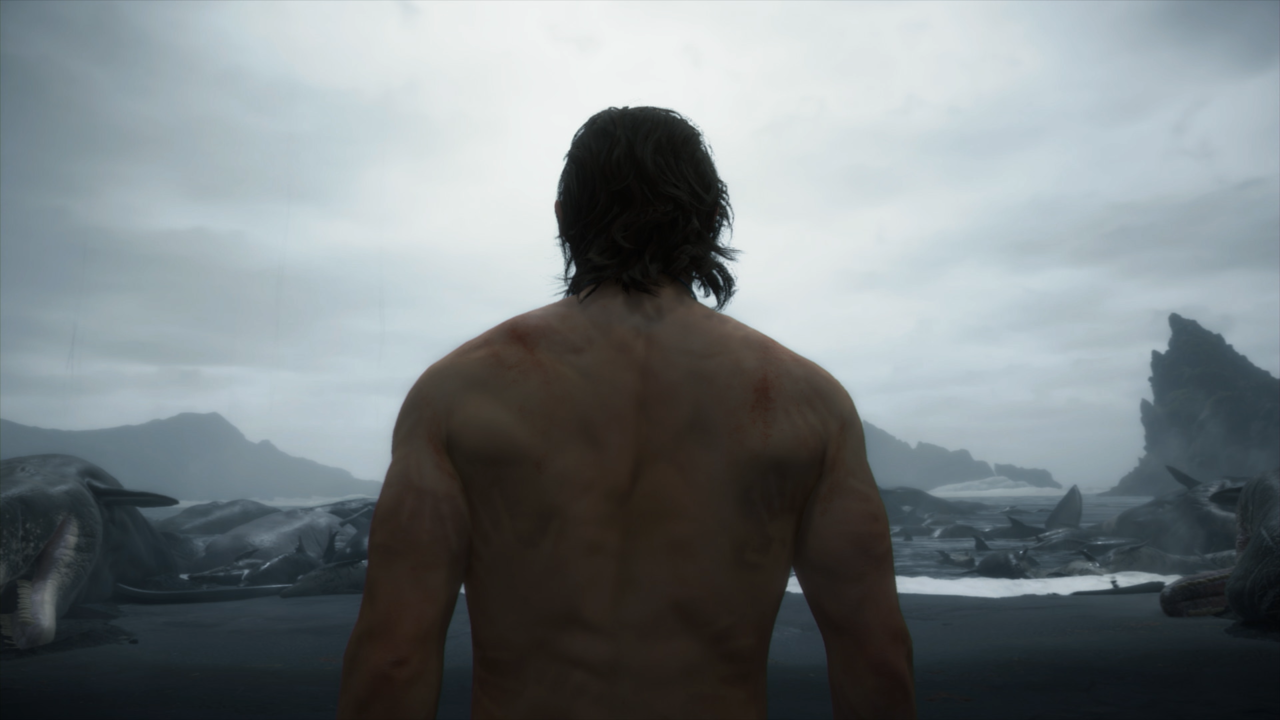
While BTs and MULEs are a concern when delivering cargo, there's also Mads Mikkelsen's character, a man who's introduced through memories Sam sees when he connects to BB's pod. He gets his own dedicated segments that punctuate hours of simple deliveries, and these highly contained, much shorter sections are striking in their art direction and juxtaposition to the rest of the game. It's not immediately clear what he is, whether it's an enemy, potential friend, or something else entirely, but he's captivating in his ambiguity.
The most cartoonish enemy is Troy Baker's Higgs, a terrorist whose depravity seems to know no bounds. Of all the characters, Higgs is the weakest, with far less nuance to him than anyone else in the cast. He's really just there as a Big Bad to motivate you in a more traditional video game sense than delivering packages and helping people, but he and his band of faceless terrorists are more a means to an end than full-fledged villains. He's the catalyst for some of the major BT fights, and in the end, perhaps an extreme reminder that it's possible to stay hopeful even when things are darkest.
Death Stranding argues in both its story and its gameplay that adversity itself is what makes things worth doing and life worth living.
Death Stranding is a hard game to absorb. There are many intertwining threads to its plot, and silly names, corny moments, and heavy exposition belie an otherwise very simple message. That comes through much more clearly in the game's more mundane moments, when you find a desperately-needed ladder left behind by another player or receive a letter from an NPC thanking you for your efforts. It's positive without ignoring pain; in fact, it argues in both its story and its gameplay that adversity itself is what makes things worth doing and life worth living. It's a game that requires patience, compassion, and love, and it's also one we really need right now.



